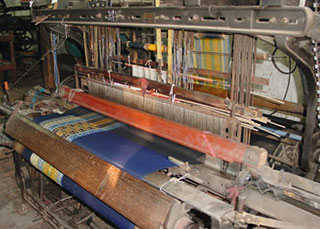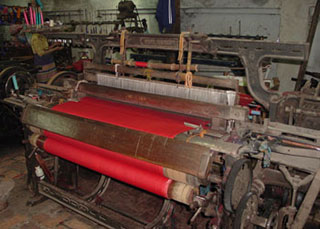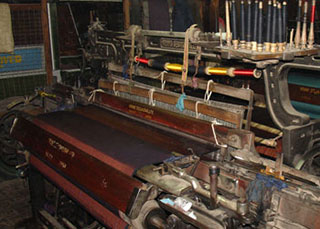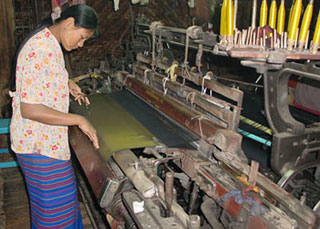Myanmars proudly wear hand-woven silk materials at auspicious occasions. Myanmar turban. Myanmar jacket and silk longyi are worn by Myanmar men while intricate acheik designs woven with over 100 silk threads such as plain silk blouses and silk shawls are proudly worn by Myanmar ladies. Although the colours and patterns of silk-woven materials have changed since the time of Myanmar kings. they are still proudly worn by Myanmars. When we weave the silk firstly. three or four raw silk threads are twisted tightly with the aid of the machine. thus making it taut and smooth. After that. silk-woven faces are removed by washing in boiled soap-nut liquid.


You will have to boil and wash more thoroughly the threads. which are to be used for the designs. because they need to be softer than ordinary silk thread. Then you have to add the desire colour you want. to the boiled water. After dyeing the threads for about 30 minutes. you have to rinse the excessive dye from the threads. Then use water. repeatedly to wash the dyed threads and later dry them in the sunlight. In this way. you get beautiful smooth dyed-silk threads. To weave the silk threads; you wind the right amount of threads; you will be needing. into the bobbins you’re going to use.
After attaching the bobbins on the loom. the weavers will weave the desired acheik patterns. The acheik patterns are horizontal wavy lines of various sizes and numbers. There are up to 300 small bobbins used to weave very intricate and complicated acheik designs. Traditionally. acheiks have named like royal thread. 6 design thread. 5 design thread. 4 design thread and so forth. depending on the usage of colour and the number of small bobbins used for the particular design. In olden days. people used to prefer the acheik with more colours. But nowadays people prefer soft and smooth silk threads with the only addition of 2 to 3 colours.
Acheik nowadays based on traditional designs woven with more modern colours and designs is still winning the heart of the locals and foreign visitors. Both. women and men folks wear lovely. colourful silk acheiks to special occasions like weddings and important festive ceremonies. Men’s silk have diamond. jasmine or pearl designs. In Amarapura city. not far from Mandalay. 100-shutles looms acheik. pasoes and shawls are woven in a variety of designs and colours.


We are now going to present the process of making Lun Yar Kyaw which is one of the Myanmar Traditional Fabrics. First of all. the white silk is dyed according to one’s liking.The dyed silk is made into yarn by using a small spindle and put into the wooden spool. These are used as a hitching-post when weaving. Simultaneously. yarn of various colour is mixed and made into a whole yarn according to the number of yarn one desires. These mixed yarn are then transferred into the small bamboo spool in the desired amount from the wooden shuttle. These are to put into the small loom for use in weaving.
Dividing upper and lower yarn from hitching-post is made by hand using big spindle.After that. yarn from the big spindle are put into wooden spool. To weave easily. putting yarn is carried out. These yarns are put into the frame of the reed in a loom. If you finish carrying out these tasks. it is ready for weaving.
When you have chosen the design. weaving can take place. It is very difficult to weave the 100 shuttle fabric. Much waft and weave to create the wavy design. It takes about three years to learn the art. Depending on the design. 100 or more looms are used. Therefore. it is called Lun Yar Kyaw which means fabric specially woven with a hundred or two hundred shuttles of multi-coloured silk thread.
Patience is needed so much so that is also called wavy pattern which means Myanmar silk fabrics with intricate wavy design or pattern. 2 or 3 girls are employed in weaving machine. To finish a fabric for one person. it take at least one month.Mirror is used to check because designs are woven up-side down. Right leg presses first and shuttle is put when upper yarn and lower yarn are kept open.
Shuttle is woven for entire line and only a frame of the reed in a loom is used. If you finish carrying out these tasks. it is ready for weaving. When the weaving is done. the fabric’s edge are cut with a pair of scissors and a systematic Lun Yar Kyaw fabric is obtained.There are altogether (50) to (70) patterns of Lun Yar Kyaw fabric. It varies from pattern of the Royal Era to these days like Sabei kon. Pan Bayin. Thonn Yaung Che and Da wei sin.
To put in a nut shell. beautiful Lun Yar Kyaw fabrics are being woven all the year round for Myanmar women.
